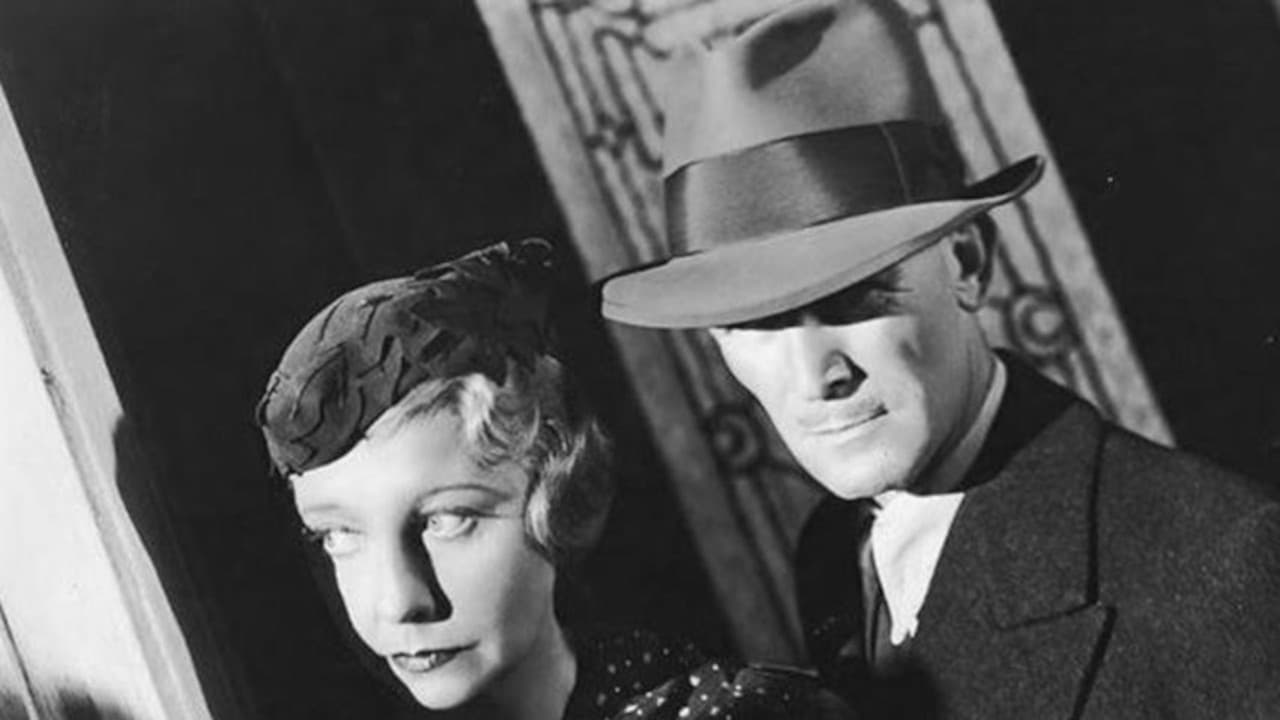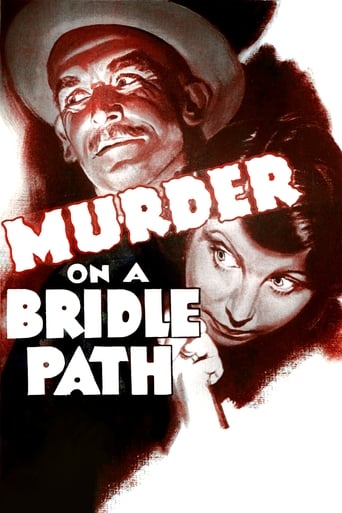

I was reading the review by Calvinnme and agree heartily. If the viewer never saw the previous Hildegard Withers films that starred Edna May Oliver, you might enjoy "Murder on a Bridle Path" even more. While Helen Broderick is very good in this role, Oliver was just better as Hildegard. Apparently, Oliver and the studio had a 'parting of the ways' and they unsuccessfully tried Broderick and later Zasu Pitts in Oliver's place. But, no matter how they tried, no one could match the charming crankiness of the original! The film starts with a blonde lady being disagreeable with several folks--a clear giveaway that she'll soon be murdered (it's a standard cliché in mystery films of the time). VERY soon after, she's killed while out riding her horse. Again, Calvinnme was right--this character wasn't developed enough and her death came too quickly. The police assume she died by accident but soon they notice a few clues that indicate she was NOT killed by being kicked by a horse. Around this time, Hildegarde shows up and immediately begins digging for clues. Like any murder mystery of the era, there are lots of dead ends and twists--along with a VERY florid ending involving the murderer--and it's by far the best part of the movie.This is a pretty good mystery film. Unfortunately, the snappy dialog from Withers isn't as obvious--not just due to Broderick but because the writing is a bit less snappy. Enjoyable but that's really about all.
... View MoreMurder on a Bridle Path (1936) ** (out of 4) The fourth film in RKO's Hildegarde Withers series was the first after Edna May Oliver stepped away from the part and was replaced by Helen Broderick for the first and only time. In the film a society woman is out riding her horse when she's thrown from it and then murdered. Detective Piper (James Gleason) thinks it's a simple case of her being killed by the fall but Withers comes across the scene and notices that the woman was murdered after the fall. The two team up to track down the usual suspects. MURDER ON A BRIDLE PATH isn't as bad as its reputation but at the same time there's no question that it's a major fall from the previous three movies. There's no doubt that Broderick isn't nearly as good as Edna May Oliver but she isn't too bad here. I thought she was decent for what was being asked as she has no problem playing the smart woman and she at least makes us believe she's a lot smarter than Piper for what that's worth. As usual Gleason is very good in his part as the rather slow Detective who is always one step behind the lady. While both actors do a fine job, the same can't be said with their comic timing and chemistry. I think what really hurts the movie is the fact that the two don't share the same spark as in the previous three films. The screenplay isn't the greatest thing either because there's never any clear case of who the killer is and when he's revealed it really seems like a stretch. As is the case in most weaker written mysteries, the police and Withers would have never found out had the killer not given himself away and of course breaking to the point where he tells everything. In the end this film is pretty much on par with the majority of "B" mysteries that were released throughout the decade but at the same time it also makes you appreciate the first three films for how special they were.
... View MoreThis series started out as one of the many experiments in building a detective narrative (where we share the unrolling of the narrative with a character) based on specific personality types. The original idea was to harden the Miss Marple type and recast her as brusque matron with a mischievous bent. And the detective would be a snappy, skinny hardnosed type who ends up a softy with this schoolmarm. In the first episode, they actually run off to get married, a situation forgotten later.But all these experiments ran out of gas, even the "Thin Man" thread. By this edition, we have a whole different set of goals, and of course a different Hildegard. This woman isn't old, imperious, thickbottomed and selfish. She's a much hipper soul and in any case she doesn't have the focus any more.And despite there being a younger sister cast for her figure, this is all about the men. And the characters we (as guys) create. Its nothing more than that, and as big as that. (The plot revolves around an exhusband thrown in "alimony jail" because of slow payments.)Gleason is at his most extreme, strutting with a smile. Its a smile of an actor winking at the audience, something that was passed through (in my small experience) Red Skelton, Burt Reynolds, Bruce Willis.But the extraordinary thing and this may not be readable to some is that it is all done by acting with hats. Its an amazing experience. These are theatrical hats, a bit over-sized. All the important facial expressions have a hat equivalent or compliment. One of the men actors is a black man playing a specific character type, a dim, stepinfetchit "boy" named Highpockets. In life, it reflects as a stereotype and is harmful because no one can deny racism. But as a character its fantastic and comes less from society directly than a long and honorable stage minstrel tradition, Watch his hat.There are other "stereotypes," a dumb Irishman, a stilted German... but none as gracefully presented.If the world were all hats, there would be no problems, no war, except maybe alimony.Its set in Central Park, though not actually shot there. Too bad.Ted's Evaluation -- 2 of 3: Has some interesting elements.
... View MoreThe underrated fourth entry in the six film series drawn from Stuart Palmer's "Hirdegarde Withers" mysteries ironically has as its greatest strength its greatest weakness: delightful lead Helen Broderick.The idea to replace the perfect Withers, the arch and tightly corseted Edna May Oliver with the sophisticated, spiritually if not literally uncorseted Broderick would seem to have been grounded in the wonderful wise cracking relationship Withers had with James Gleason's much put-upon Inspector Oscar Piper, and to that extent it works. Broderick, the beloved sophisticate of the Fred Astaire films TOP HAT and SWING TIME, gets off some good ones ("Oh, I have some influence with Inspector Piper; we used to room together in college!"), but it's hard to picture her as the prim school teacher that Palmer's Miss Withers says she is.The film has the further drawback for some modern audiences in incorporating some of the racist stereotypes of the era in Willie "High Pockets" Best's excellent performance as the slow but steadfast stable boy who may be near the center of the mystery. In 42 films from 1934 to 1947 (just to consider the ones reviewed in the New York Times - some, like HIGH SIERRA and CABIN IN THE SKY, genuine classics), Best took the work Hollywood offered and made his characters shine - whatever limitations Hollywood may have placed on the casting of black actors.MURDER ON A BRIDLE PATH has a good cast all around (among the series regulars, James Gleason's Piper, James Donlan's comic detective and Gustav Von Seyffertitz's police doctor are some of their best performances), and boasts an excellent mystery at the core. The OBSERVANT viewer even has an honest chance to beat Withers and Piper to the solution despite some delicious red herrings along the way. Radio Pictures had clearly moved the series to a back burner when Oliver left (no more "name" producers and even Max Steiner's musical contributions went uncredited this time), but at least with Broderick finding the clues and lending a major hand with the comedy, the quality stayed high. Later in the year, the studio would turn to Zasu Pitts for two final "Miss Withers" films, and while she would return the unsophisticated primness to the character and (in small doses) Pitt could be a brilliant diffident comedienne, the quality of the writing and the chemistry between Hildegarde and Oscar never regained the level it had maintained with Edna May Oliver and Helen Broderick.It's a pity, because the franchise was one of the more enjoyable creations of the 30's when the "cozy" mystery was at its peak and every studio seemed to be trying their hand at popularizing distinctive detectives from Philo Vance and Nick & Nora Charles to Charlie Chan and Mr. Moto. Miss Withers is missed.
... View More